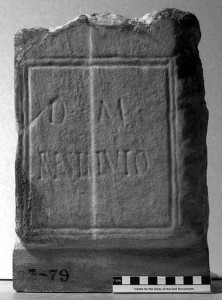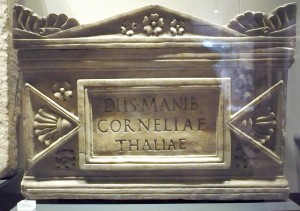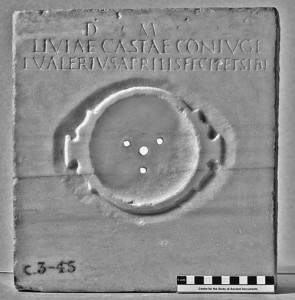Back in early September, AshLI challenged Twitter followers of @AshmoleanLatin to read a tiny bronze plaque in the Ashmolean Collection. By the end of the day, we were really getting somewhere: After some clever sleuthing from classics-lovers and amateur epigraphers,…
Tag: Ashmolean
On the Feast of Saturnalia, my master gave to me…
A Roman Slave’s Carol As the shortest day of the year drew near, the Romans crossed their fingers for a kind winter and people from all walks of life made a break in their usual routine to honour the harvest…
Classics Teachers get special access to Ashmolean on “Teaching with Ancient Artefacts” Day
On 22nd November 2014, 38 teachers from around the UK came to Oxford for a one-day course on how to use ancient artefacts in their teaching. The day was organised by the Ashmolean Latin Inscription Project (AshLI), and delivered by…
Did the Romans believe in ghosts?
The haunted house…
It was a sprawling town house that anyone would have been proud to own. But every night, the sound of clanking chains and a terrifying vision of an old man, his shaggy hair crusted with filth, woke the inhabitants. With each visitation, their terror grew until, sick with sleeplessness, they abandoned the house. It was put up for sale, but no-one would go near it. Then, one day, a man arrived in town, a man famous for his rational mind. A man who didn’t believe in ghosts. Dr Llewelyn Morgan picks up the story with a recording he made especially for AshLI:
The story of Athenodoros and the haunted house comes from the turn of the second century AD, in a letter from Pliny the Younger to his friend Sura (Pliny, Letters VII.27).
Spookily familiar
The basic story – a place is haunted by a ghost who can find no peace until its bones are found and laid to rest – is a very familiar one (The Woman in Black, Coraline, and Sleepy Hollow all rely on it). It’s also very ancient. In Homer’s Odyssey XI, Odysseus meets the ghost of his comrade Elpenor in Hades, and discovers that he’s been left behind on Circe’s island. Elpenor had rolled off the roof where he was sleeping and broken his neck, and needs a proper burial.
The many faces of the Roman ghost
In modern, Western culture, ghosts are often associated with this kind of unfinished business. Set against the Christian tradition of heaven and an appealing afterlife, ghosts often need to have a good reason to be hanging around on earth when they could be somewhere better. But the Romans didn’t have just one idea about ghosts. Some, like the old man in Pliny’s story, were lemures, angry or overlooked spirits, who could cause trouble for the living. They were honoured annually with a series of feast days in May. Not surprisingly, lemures mostly appear in Latin literature (e.g. Ovid’s Fasti 5), since they tend to make good stories. Others ghosts were members of the natural, and ever-increasing band of dead ancestors and close relatives, who functioned as guiding and protective forces in Roman daily life. These spirits, the manes, were imagined as being in or under the earth, and were celebrated with a nine-day festival, the Parentalia, in February, and were often described as gods (di). The distinction between gods and protective spirits wasn’t one which the Romans would have worried too much about.
‘Dis Manibus’
It’s the assembled ranks of this second type of ghost, the ancestor-spirit, which are extremely common in Latin inscriptions. Roman tombstones often open with two letters: DM, short for dis manibus – ‘To the spirits of the departed’. It’s an address to those who have gone before which alerts them that another spirit is on its way, and is commended to their care. Even if the rest of the inscription is broken off, worn away, or downright horrible, the opening letters DM mean that we can be sure we’re dealing with a tombstone, and not some other type of inscription.
If we’re really lucky, the stonecutter might have included a slightly longer abbreviation, like the DIIS (this time with double ‘i’) MANIB we see on this ash-urn currently on display in the Ashmolean’s Rome gallery:
A toast for a ghost
One of the ways that the Romans kept the di manes happy was by making offerings. A recently deceased relative and the rest of the di manes could be honoured by pouring libations or leaving food on or near the grave. One of the pieces that the Ashmolean Latin Inscriptions Project hopes to put on display in 2015 is a remarkable tombstone for a woman named Livia Casta. In the middle of the stone is a relief carving of a Roman cup, pierced with four holes. The stone was originally set horizontally so that Livia Casta’s relatives could pour wine, honey and water offerings into the cup, which would drain through onto her ashes where she could enjoy it. Honouring the ghosts of dead relatives and the wider band of di manes was really a question of keeping them involved, and making sure they had their share of pleasures like food and drink.
Did the Romans believe in ghosts?
It’s always dangerous to make generalisations about what an entire culture believed. It’s tempting to use the evidence in literature and inscriptions to draw conclusions about what the Romans thought, but plenty of people read (and write) ghost stories without necessarily being convinced about the existence of ghosts, and plenty of people ask for things to be caved on tombstones because they’re traditional. Some Romans probably believed in ghosts, and some probably didn’t. But what’s very clear is that the Romans liked the idea of ghosts, and used them in various different ways: for managing luck, for keeping family memories alive and even, just like us, for telling scary stories.
A more detailed discussion of the Latin inscriptions shown here, with full bibliographic references, will appear in the new catalogue of the Ashmolean Latin Inscriptions, which will be freely available online before 2016.
Getting rid of Geta – a scruffy inscription concealing a dark deed
How Roman Britons kept on the good side of a bad emperor In 1672, a Roman altar was found on the south bank of the River Tyne at South Shields. Measuring over a meter in height, it had images of…
The Roman soldier who went to Newcastle and punched Hercules
Test your decipherment skills on a bronze plaque from Roman Britain On a shelf in the Ashmolean’s Rome Gallery, eagle-eyed visitors might spot a tiny bronze plaque, with a rectangular body and triangular handles (a shape called a tabula ansata).…
‘He lived 5 years, 2 months, 6 days, 6 hours’ – The Roman child-slave and the woman who loved him
In 1667, Henry Howard, grandson of Thomas Howard 2nd Earl of Arundel, presented Oxford University with a collection of inscriptions which today belong to the Ashmolean Museum. Among the collection is ANChandler.3.90, a badly worn marble tombstone from Rome. While…
When is a Roman not a Roman? International relations on Duty Free Delos
A bilingual inscription from Delos. Ashmolean Museum ANMichaelis.209. (H. 0.84cm. Diam. 0.70cm) Duty Free Delos In the second century BC, the little Greek island of Delos in the Cyclades experienced an unexpected boom, as it became the place to…
Now you see it, now you don’t: a disappearing text from Roman Chester
Ashmolean ANChandler3.1. Red Sandstone Altar from Chester (H. 0.97, W. 0.45, D. 0.43). AD 154. Looking Blank On display in the Ashmolean’s Ark to Ashmolean gallery stands a red sandstone altar. On three of its sides there are relief…
The Latin Inscription Project Goes Live!
A new project to redisplay and re catalogue the Latin Inscriptions at the Ashmolean Museum began in Autumn 2013. Over the next 3 years, the project will focus on making Latin inscriptions accessible to a wide audience, from school children…




